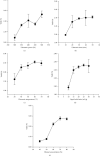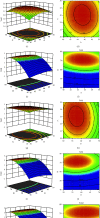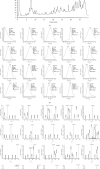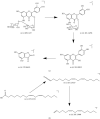Extraction Optimization, Preliminary Identification, and Bioactivities in Corn Silk
- PMID: 36777625
- PMCID: PMC9911244
- DOI: 10.1155/2023/5685174
Extraction Optimization, Preliminary Identification, and Bioactivities in Corn Silk
Abstract
For thousands of years, corn silk has been widely used as an antidiabetic, antioxidant, and antihyperlipidemic and for other effects, but there is a lack of studies that correlate the extracts of flavonoid composition with their biological activities. Thus, the objectives of this study were to optimize the conditions for extracting flavonoids, identify flavonoids, and correlate the flavonoid composition with the biological activities in corn silk. The response surface experiments showed that the highest flavonoid content was predicted at 45.321 min, 57.349°C, 26.089 mL/g, and 71.269%, respectively. The verification experiment results under these optimized conditions showed an ultrasonic time of 45 min, an ultrasonic temperature of 57°C, a liquid-to-material ratio of 26, and an ethanol volume fraction of 70%. No significant differences (the relative error is 4.378%) were observed between the theoretical and experimental TFC values, indicating that the developed models were accurate. Under these optimum extraction conditions, 20 major compounds were identified and quantified by UPLC-LTQ/Orbitrap MS. Furthermore, these optimum ethanol extracts of corn silk are effective against Bacillus subtilis and hypoglycemic activity compared with the traditional heating reflux extraction method. Six corn silk components seem to be the main contributors to the inhibitory effect against Bacillus subtilis and hyperglycemia activities. These results are useful for the application of corn silk in the food or pharmaceutical industry.
Copyright © 2023 Ping Li et al.
Conflict of interest statement
The authors declare no conflicts of interest.
Figures








Similar articles
-
Authentication, chemical profiles analysis, and quality evaluation of corn silk via DNA barcoding and UPLC-LTQ/Orbitrap MS chemical profiling.Food Res Int. 2023 May;167:112667. doi: 10.1016/j.foodres.2023.112667. Epub 2023 Mar 13. Food Res Int. 2023. PMID: 37087254
-
Optimization of Flavonoid Extraction from Red and Brown Rice Bran and Evaluation of the Antioxidant Properties.Molecules. 2018 Jul 26;23(8):1863. doi: 10.3390/molecules23081863. Molecules. 2018. PMID: 30049990 Free PMC article.
-
Optimizing extraction conditions and isolation of bound phenolic compounds from corn silk (Stigma maydis) and their antioxidant effects.J Food Sci. 2023 Aug;88(8):3341-3356. doi: 10.1111/1750-3841.16682. Epub 2023 Jul 8. J Food Sci. 2023. PMID: 37421346
-
Bioactive compounds of corn silk and their role in management of glycaemic response.J Food Sci Technol. 2023 Jun;60(6):1695-1710. doi: 10.1007/s13197-022-05442-z. Epub 2022 Apr 10. J Food Sci Technol. 2023. PMID: 37187994 Free PMC article. Review.
-
Research Progress on Extraction and Detection Technologies of Flavonoid Compounds in Foods.Foods. 2024 Feb 19;13(4):628. doi: 10.3390/foods13040628. Foods. 2024. PMID: 38397605 Free PMC article. Review.
Cited by
-
Mechanism of flavonoids in the treatment of gouty arthritis (Review).Mol Med Rep. 2024 Aug;30(2):132. doi: 10.3892/mmr.2024.13256. Epub 2024 May 31. Mol Med Rep. 2024. PMID: 38818832 Free PMC article. Review.
References
-
- Li C. C., Lee Y. C., Lo H. Y., Huang Y. W., Hsiang C. Y., Ho T. Y. Antihypertensive effects of corn silk extract and its novel bioactive constituent in spontaneously hypertensive rats: the involvement of angiotensin-converting enzyme inhibition. Molecules . 2019;24(10):p. 1886. doi: 10.3390/molecules24101886. - DOI - PMC - PubMed
-
- Li Y., Hu Z., Wang X., Wu M., Zhou H., Zhang Y. Characterization of a polysaccharide with antioxidant and anti-cervical cancer potentials from the corn silk cultivated in Jilin province. International Journal of Biological Macromolecules . 2020;155:1105–1113. doi: 10.1016/j.ijbiomac.2019.11.077. - DOI - PubMed
LinkOut - more resources
Full Text Sources
Molecular Biology Databases

